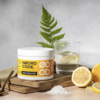Whey protein concentrate: beyond protein
What whey protein concentrate is | Whey protein concentrate and cysteine | Whey protein concentrate and lactoferrin | Whey protein concentrate and immunoglobulins | How do you identify a quality whey protein concentrate?
Whey protein is often associated with bodybuilders. It has gotten a bad name over the years as a highly processed protein powder. Undeserved because today whey protein is not nearly as processed as it was.
Whey contains all the amino acids your body needs, therefore it has a higher biological value than plant-based protein. The complete amino acid profile makes whey a high-quality protein. It is good for muscle growth and maintaining strong bones, but whey is much more than that.
We all know that breast milk is healthy for a baby. Whey protein concentrate has similar characteristics, where whey protein isolate and hydrolysate have less of that because they are more processed. Therefore, in this article we will focus mainly on whey protein concentrate. Let's discuss its three main properties: cysteine, lactoferrin and immunoglobulins. But first: what exactly is whey protein concentrate?
What whey protein concentrate is
Whey is a residual product of cheese production. After adding rennet to milk, whey and curd remain. The liquid whey is then dried to a powdered form.
Whey protein concentrate contains mainly protein (80%). The rest is fat, carbohydrates and valuable bioactive compounds. These constituents, including cysteine, lactoferrin and immunoglobulins, make whey protein concentrate unique.
Other options include whey protein isolate or even hydrolisate, which is further filtered to increase protein content and absorbability. Although as a result, it loses some of those special compounds during the manufacturing process. First of all, that's cysteine, but also lactoferrin and immunoglobulins. More on that below.
Whey protein concentrate and cysteine
You may already be familiar with glutathione as a supplement, but in fact, glutathione is an antioxidant that we make ourselves. Amino acids, vitamins and minerals in food all play an important role in the production of glutathione. The best known of these is whey protein. Whey protein contains high concentrations of the amino acid cysteine. This is the main precursor for glutathione production.
In the late 1980s, researchers discovered that heat and processing of whey protein significantly reduces the amount of cysteine (and other relevant constituents). For optimal benefits for glutathione production, you want as little heated and processed whey protein as possible.
Most studies (by Bounous et al.) on the relationship between whey protein and glutathione production have therefore been done with undenatured (meaning the whey has been heated no more than 30 degrees) whey protein concentrate, the least processed form of whey protein. However, the whey protein used in the study was irradiated to kill any bacteria. Irradiation is not allowed for organic products within Europe.
Undenatured versus pasteurized
There are different degrees of pasteurization. A 2001 study (Morales et al.) investigated the impact of the common/commercial method of pasteurization called High-temperature short-time (HTST) on the glutathione-promoting constituents in whey protein. 65 degrees for 15 seconds destroyed 40%. Heating the milk at 85 degrees in 30 seconds destroyed 77% of the constituents.
Whey protein heated with Ultra-high temperature (UHT) pasteurization (138-150 °C for 1-2 sec.) suffered even more heat damage during processing and therefore was no longer able to increase glutathione.
&&&&&
Whey protein concentrate and lactoferrin
Lactoferrin is an anti-inflammatory protein and antioxidant that occurs naturally in the body. The name Lactoferrin refers to cow's milk. Lactoferrin is therefore found in abundance in whey protein. Ferrin stands for iron because Lactoferrin has the property of binding and transporting iron.
We get lactoferrin in large quantities immediately after birth, thanks to drinking colostrum and breast milk. Babies ingest as much as two to three grams of lactoferrin. Although our bodies produce their own lactoferrin, we never consume it again in such high doses as we did early in life. A Western lifestyle with a lot of highly processed food, a lot of (chronic) stress and exposure to all kinds of (environmental) toxins has a negative influence on your own reserves of lactoferrin.
You can stimulate your own production of lactoferrin by exercising, preferably a fast sprint. The best way to get lactoferrin through an external source is with 20 to 40 grams of whey protein.
Whey protein concentrate and immunoglobulins
Immunoglobulin has an important immunological function. It is transmitted in utero from mother to child through the umbilical cord and by breastfeeding. This is the initial formation of the immune system. In this way, newborns are protected from disease by passive immunity (via lactoferrin and immunoglobulins).
Milk whey has also been found to contain a significant amount of immunoglobulins, about 10-15 percent of total whey protein.
So far, most studies on the effect of immunoglobulins on the immune system have focused on newborn ruminants, such as calves. More recent research focuses on the effect in humans.
In addition to cysteine, lactoferrin and immunoglobulins, whey protein contains many other unique components, amino acids, growth factors and bioactive peptides. To give you an idea of the amount of nutrients whey protein contains, here is an overview of the most important biological substances:
- Immunoglobulins (A, M and C)
- Lactoferrin
- β-Lactoglobulin
- α-Lactalbumin
- Serum albumin
- Glycomacropeptide
- IGF-1
- IGF-2
- Transforming growth factor (TGF)-b
- Platelet-derived growth factor (Platelet-derived growth factor)
- Fibroblast growth factor (FGF)
- Betacellulin
How do you identify a quality whey protein concentrate?
It is now clear to you that you would rather go for a whey protein concentrate. One that has been heated and processed as little as possible (within what is allowed according to European guidelines), to preserve the numbers of cysteine, lactoferrin and immunoglobulins as much as possible.
It does cost a little more, but by investing in a 100% grass-fed and certified organic product, you are supporting organic farming and the sustainability of our planet. Cows get the space they need in the pasture. They naturally fertilize the soil with their manure and produce better quality milk with a more favorable nutritional profile.
Finally, check the label for additives such as sugar, artificial sweeteners, and artificial flavors and colors.
In short, the best whey protein concentrate is:
- Grass-fed
- Organic
- Not irradiated to keep nutrients intact as much as possible
- Heated and processed as little as possible
- Tested for amino acids
- Naturally flavored (or flavorless)
- Sugar free
- Free of artificial sweeteners
- Formulated without emulsifiers
NoordCode Pure Whey meets all of these standards. It is a whey protein concentrate derived from organic Alpine cows grazing in pasture year-round. Because of European guidelines, it is not undenatured - but the whey protein is processed at low temperatures for 15 seconds and without irradiation to preserve the glutathione-promoting components as much as possible. Pure Whey is formulated without additives. It contains only one ingredient and that is 100% grass-fed and organic whey protein concentrate.
Resources
https://pubmed.ncbi.nlm.nih.gov/1782728/
https://pubmed.ncbi.nlm.nih.gov/2025891/
https://pubmed.ncbi.nlm.nih.gov/2692897/
https://pubmed.ncbi.nlm.nih.gov/15570142/
https://chrismasterjohnphd.com/covid-19/whey-protein-breast-milk-and-covid-19/
https://www.mdpi.com/1660-4601/18/20/10985
https://pubmed.ncbi.nlm.nih.gov/35745243/
https://www.nature.com/articles/s41392-020-00408-z
https://www.sciencedirect.com/science/article/pii/S1756464622000020
https://chrismasterjohnphd.com/covid-19/covid-19-iron-and-the-anemia-of-chronic-disease-2/
https://www.ncbi.nlm.nih.gov/pmc/articles/PMC7126817/
https://altmedrev.com/wp-content/uploads/2019/02/v9-2-136.pdf




